9 Cool Intel Edison CPU-Powered Gadgets
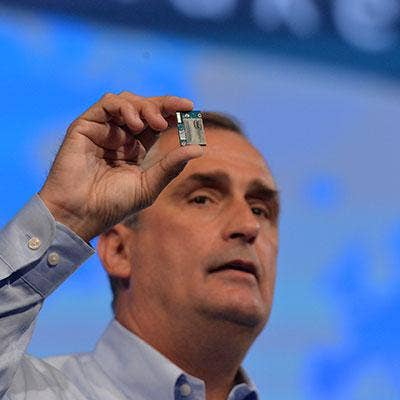
Tiny Yet Mighty Edison
Intel launched the Edison microelectronic development platform Tuesday. It's the chipmaker's low-cost ($50), low-power, small form factor general purpose computer. The company hopes the affordable stamp-sized mini computers will catch fire in the developer community and spark a new wave of Internet-connected devices, sensors and other electronics powered by Intel chips.
Intel predicts the number of wearable devices is expected to reach 320 million by 2018. Already the market is seeing tremendous momentum from a wave of fitness trackers, including the Apple Watch unveiled yesterday.
Edison, developed by Intel's New Devices Group, competes to some degree with rival platforms such as Rasberry PI and Texas Instruments' Beaglebone Black. But what sets Edison apart, Intel developers say, is Edison's much smaller size and is more powerful while at the same time more power efficient. And, most importantly, it incorporates wireless Bluetooth and Wi-Fi capabilities.
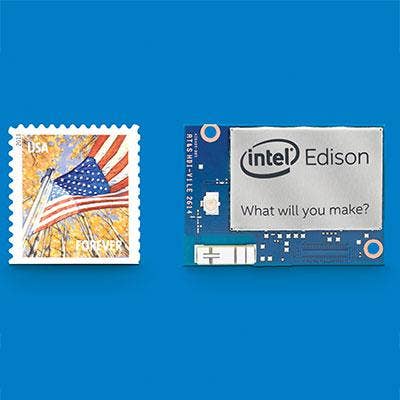
Chip Specs
The Intel Edison module uses a 22 nanometer Intel Atom SoC, formerly Silvermont that includes a dual core, dual threaded x86 CPU running at 500MHz and a 32-bit Intel Quark microcontroller running at 100MHz. Edison supports 40 GPIOs and includes a 1GB Low Power DDR3, 4GB embedded multi-media controller and dual-band 802.11 a/b/g/n and Bluetooth 4.0 radios.
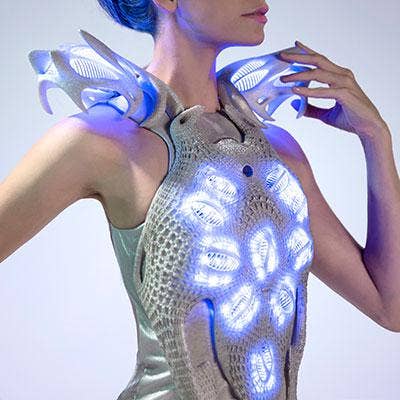
Wearable: This Digital Diva's Dress Can Tell You To Buzz Off
This proof of concept dress, designed by Dutch fashion designer Anouk Wipprecht, demonstrates Edison's possibilities as a stylish piece of clothing. The dress, according to an Intel developer, reacts differently when people come into contact with another person. LED lights mounted on the dress are designed to act different when someone comes in the wearer's intimate, personal and public space.
Lights change intensity and color based on both the wearer's biometric feedback responding to people around them and also by the proximity of people close by. A camera mounted on the dress can also take a video diary of the day by snapping pictures at times when biometric readings sensed by the dress feel it's optimal to snap a picture.
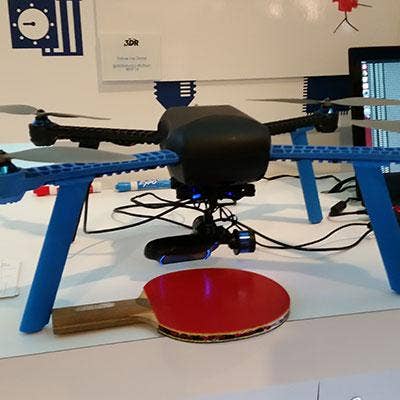
Quick, Get A Tin Foil Hat On
California-based firm 3D Robotics claims to be one of the first drone makers to create a system that can follow a subject based on visually recognizing a person autonomously instead of relying on GPS technology for tracking. On display (seen in picture) was the company's $1,000 drone that it said is ideal for taking essentially video-drone selfies from above while biking, skiing or performing other sports.
The idea, said a 3D Robotics engineer, is you would set the course of the drone using GPS technology. But once airborne, a drone can spot its target and be programed to capture video footage from above, circle the person it's tracking or just keep the subject in the center of the video frame.
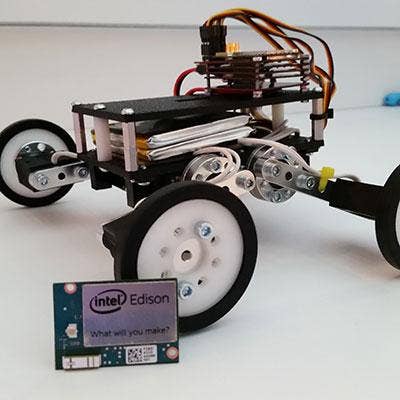
Maker Community: Harnessing The Spark Of Innovation
SparkFun has just begun selling Edison PCs to developers and so-called Maker IT hobbyists who design their own PC-powered gadgets. The company sells the Edison chip along with 14 other plug-and-build Edison boards for creating everything from nano-satellites for business to toy cars, as seen in the picture.

Fitness Tracker: Smart Bike Helmet Embeds Sensors For Safer Rides
Interns at Oregon State University and Intel produced a smart helmet prototype with Bluetooth, magnetometer, gyroscope and two accelerometers. The helmet is designed to detect a crash and communicate to predetermined emergency contacts when there is trouble.
Students say the smart helmet can also record ride distance, speed and the path a bike rider took. Developers gather the data using the smart helmet and then connect the data feed to a custom app for further analysis.
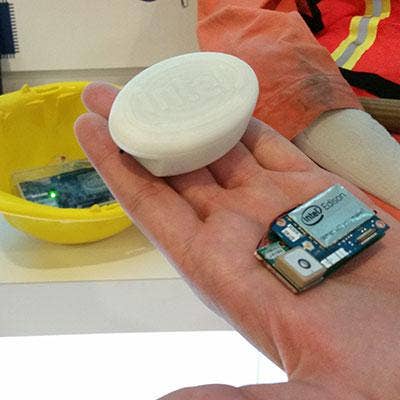
Putting Edison To Work: Hardhat 2.0
Intel embeds both gas- and smoke-sniffing sensors into a hardhat on this Edison prototype that can constantly report on environmental conditions in the field. It could be a life saver for coal miners or any field worker. These Intel Construction Helmets also have accelerometers built into them so if a construction worker either falls or gets knocked on the head, a remote monitoring program can trigger an alarm to a supervisor.
In the image to the left, Intel shows how Edison's tiny footprint can make the Smart Construction Helmet a reality by making it feasible to fit the technology into a hardhat. In the background you can see an earlier, bulkier model of the Smart Construction Helmet.
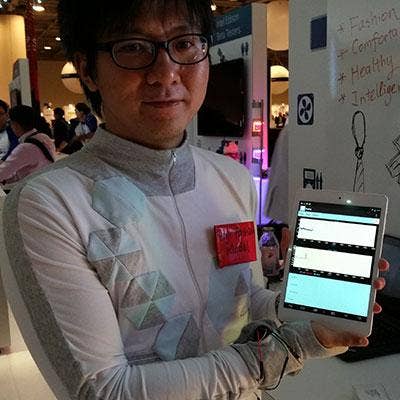
Telemedicine Monitoring Via Wearables
This is a prototype wearable peppered with sensors that include electrocardiogram, body temperature, patient positioning, pulse, oxygen in blood and galvanic skin response. You can see the wires sticking out of the sleeve of this high-tech smart shirt. The Edison-powered wearable can connect to any e-health sensor platform using either Wi-Fi or Bluetooth wireless technology. The idea is a doctor or loved one could keep tabs on someone using an e-health dashboard (see tablet in picture) dialed into monitor someone's vital signs.
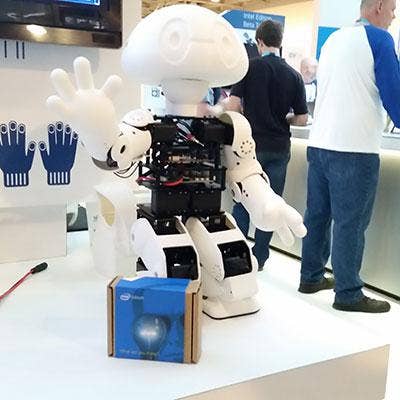
Edison, 3D Print And Customize Your Own Robot
This robot can be 3D printed and highly customized with Edison modules to perform a number of different autonomous tasks such as monitoring air quality for hazards, acting as a home security guard, tell jokes or act as your remote eyes and ears when you are away from home. Intel developers say the sky is the limit with their robot and hope robot owners will contribute to a soon-to-be-launched Robot App Store and share ideas.
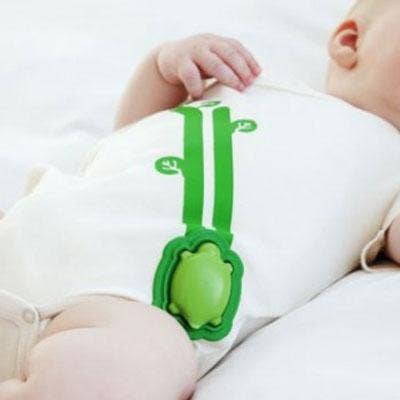
Baby Monitor On Steroids -- Or Edison
It's one thing to keep your baby within earshot using a baby monitor. Intel hopes to take keeping an eye on the baby to a whole new level with this Mimo Smart Baby Monitor. You can buy a Smart Baby Monitor Kit for $200. Intel, along with tech company Rest Devices, have developed a smart baby suite that will send "updates" to a smartphone on the baby's temperature, movement, body position and respiratory patterns.
The two green stripes that run down the front of the jumper are sensors. The Edison-powered, turtle-shaped PC pops off for recharging.
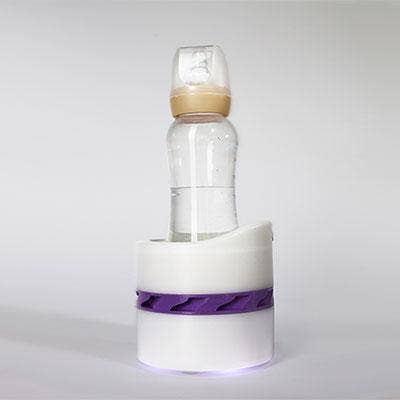
Edison Connected Devices
In this prototype baby bottle warmer, Intel is showing how smart connected devices can work together. Here a smart baby monitor is connected to both a parent's bottle warmer and smartphone. When the baby begins to stir from a nap either the bottle can automatically begin to warm or the smart baby monitor can send an alert to a smartphone app asking for permission to warm the bottle. The sensor ecosystems, Intel said, can be used for a multitude of scenarios such as coffee machines and home automated HVAC systems.